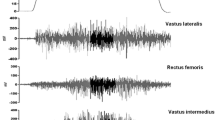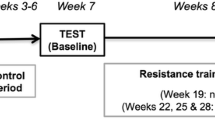Abstract
This study examined the effect of strength training (ST) and short-term detraining on maximum force and rate of force development (RFD) in previously sedentary, healthy older men. Twenty-four older men (70–80 years) were randomly assigned to a ST group (n = 12) and C group (control, n = 12). Training consisted of three sets of six to ten repetitions on an incline squat at 70–90% of one repetition maximum three times per week for 16 weeks followed by 4 weeks of detraining. Regional muscle mass was assessed before and after training by dual-energy X-ray absorptiometry. Training increased RFD, maximum bilateral isometric force, and force in 500 ms, upper leg muscle mass and strength above pre-training values (14, 25, 22, 7, 90%, respectively; P < 0.05). After 4 weeks detraining all neuromuscular variables were significantly (P < 0.05) lower than after 16 weeks training but remained significantly (P < 0.05) higher than pre-training levels except for RFD which had returned to pre-training levels. These findings demonstrate that high-intensity ST can improve maximum force and RFD of older men. However, older individuals may lose some neuromuscular performance after a period of short-term detraining and that resistance exercise should be performed on a regular basis to maintain training adaptations.
Similar content being viewed by others
References
Aagaard P, Simonsen EB, Andersen JL, Magnusson P, Dyhre-Poulsen P (2002) Increased rate of force development and neural drive of human skeletal muscle following resistance training. J Appl Physiol 93:1318–1326
Andersen LL, Andersen JL, Zebis MK, Aagaard P (2009) Early and late rate of force development: differential adaptive responses to resistance training? Scand J Med Sci Sports
Bassey EJ, Fiatarone MA, O’Neill EF, Kelly M, Evans WJ, Lipsitz LA (1992) Leg extensor power and functional performance in very old men and women. Clin Sci (Lond) 82:321–327
Bellew JW, Yates J, Gater DR, Clasey J (2003) Explosive force production in older adults following a traditional strength training program. J Geriatr Phys Ther 26:9–13
Caserotti P, Aagaard P, Larsen JB, Puggaard L (2008) Explosive heavy-resistance training in old and very old adults: changes in rapid muscle force, strength and power. Scand J Med Sci Sports 18:773–782
Chrusch MJ, Chilibeck PD, Chad KE, Davison KS, Burke DG (2001) Creatine supplementation combined with resistance training in older men. Med Sci Sports Exerc 33:2111–2117
D’Antona G, Pellegrino MA, Adami R, Rossi R, Carlizzi CN, Canepari M, Saltin B, Bottinelli R (2003) The effect of ageing and immobilization on structure and function of human skeletal muscle fibres. J Physiol 552:499–511
Daley MJ, Spinks WL (2000) Exercise, mobility and aging. Sports Med 29:1–12
Dreyer HC, Schroeder ET, Hawkins SA, Marcell TJ, Tarpenning KM, Vallejo AF, Jensky NE, Shaibi GQ, Spears S, Yamada R, Wiswell RA (2006) Chronic exercise and skeletal muscle power in older men. Appl Physiol Nutr Metab 31:190–195
Fatouros IG, Kambas A, Katrabasas I, Nikolaidis K, Chatzinikolaou A, Leontsini D, Taxildaris K (2005) Strength training and detraining effects on muscular strength, anaerobic power, and mobility of inactive older men are intensity dependent. Br J Sports Med 39:776–780
Fleck SJ, Kraemer WJ (2004) Designing resistance training programs. Human Kinetics, Champaign
Fleming BE, Wilson DR, Pendergast DR (1991) A portable, easily performed muscle power test and its association with falls by elderly persons. Arch Phys Med Rehabil 72:886–889
Frontera WR, Meredith CN, O’Reilly KP, Knuttgen HG, Evans WJ (1988) Strength conditioning in older men: skeletal muscle hypertrophy and improved function. J Appl Physiol 64:1038–1044
Gabriel DA, Kamen G, Frost G (2006) Neural adaptations to resistive exercise: mechanisms and recommendations for training practices. Sports Med 36:133–149
Hakkinen K, Newton RU, Gordon SE, McCormick M, Volek JS, Nindl BC, Gotshalk LA, Campbell WW, Evans WJ, Hakkinen A, Humphries BJ, Kraemer WJ (1998) Changes in muscle morphology, electromyographic activity, and force production characteristics during progressive strength training in young and older men. J Gerontol A Biol Sci Med Sci 53:B415–B423
Hakkinen K, Alen M, Kallinen M, Newton RU, Kraemer WJ (2000) Neuromuscular adaptation during prolonged strength training, detraining and re-strength-training in middle-aged and elderly people. Eur J Appl Physiol 83:51–62
Harries UJ, Bassey EJ (1990) Torque-velocity relationships for the knee extensors in women in their 3rd and 7th decades. Eur J Appl Physiol 60:187–190
Hazell T, Kenno K, Jakobi J (2007) Functional benefit of power training for older adults. J Aging Phys Act 15:349–359
Henwood TR, Taaffe DR (2008) Detraining and retraining in older adults following long-term muscle power or muscle strength specific training. J Gerontol A Biol Sci Med Sci 63:751–758
Heymsfield SB, Smith R, Aulet M, Bensen B, Lichtman S, Wang J, Pierson RN Jr (1990) Appendicular skeletal muscle mass: measurement by dual-photon absorptiometry. Am J Clin Nutr 52:214–218
Ivey FM, Tracy BL, Lemmer JT, NessAiver M, Metter EJ, Fozard JL, Hurley BF (2000) Effects of strength training and detraining on muscle quality: age and gender comparisons. J Gerontol A Biol Sci Med Sci 55:B152–B157; discussion B158–B159
Izquierdo M, Hakkinen K, Ibanez J, Garrues M, Anton A, Zuniga A, Larrion JL, Gorostiaga EM (2001) Effects of strength training on muscle power and serum hormones in middle-aged and older men. J Appl Physiol 90:1497–1507
Kostka T (2005) Quadriceps maximal power and optimal shortening velocity in 335 men aged 23–88 years. Eur J Appl Physiol 95:140–145
Latham NK, Bennett DA, Stretton CM, Anderson CS (2004) Systematic review of progressive resistance strength training in older adults. J Gerontol A Biol Sci Med Sci 59:48–61
Lemmer JT, Hurlbut DE, Martel GF, Tracy BL, Ivey FM, Metter EJ, Fozard JL, Fleg JL, Hurley BF (2000) Age and gender responses to strength training and detraining. Med Sci Sports Exerc 32:1505–1512
Levinger I, Goodman C, Hare DL, Jerums G, Toia D, Selig S (2007) The reliability of the 1RM strength test for untrained middle-aged individuals. J Sci Med Sport 12(2):310–316
Lexell J, Taylor CC, Sjostrom M (1988) What is the cause of the ageing atrophy? Total number, size and proportion of different fiber types studied in whole vastus lateralis muscle from 15- to 83-year-old men. J Neurol Sci 84:275–294
Macaluso A, De Vito G (2004) Muscle strength, power and adaptations to resistance training in older people. Eur J Appl Physiol 91:450–472
Newton RU, Hakkinen K, Hakkinen A, McCormick M, Volek J, Kraemer WJ (2002) Mixed-methods resistance training increases power and strength of young and older men. Med Sci Sports Exerc 34:1367–1375
Sale DG (1988) Neural adaptation to resistance training. Med Sci Sports Exerc 20:S135–S145
Seynnes O, Fiatarone Singh MA, Hue O, Pras P, Legros P, Bernard PL (2004) Physiological and functional responses to low-moderate versus high-intensity progressive resistance training in frail elders. J Gerontol A Biol Sci Med Sci 59:503–509
Sforzo GA, McManis BG, Black D, Luniewski D, Scriber KC (1995) Resilience to exercise detraining in healthy older adults. J Am Geriatr Soc 43:209–215
Taaffe DR, Marcus R (1997) Dynamic muscle strength alterations to detraining and retraining in elderly men. Clin Physiol 17:311–324
Thorstensson A, Grimby G, Karlsson J (1976) Force-velocity relations and fiber composition in human knee extensor muscles. J Appl Physiol 40:12–16
Trappe S, Williamson D, Godard M (2002) Maintenance of whole muscle strength and size following resistance training in older men. J Gerontol A Biol Sci Med Sci 57:B138–B143
Vandervoot AA, Symons TB (2001) Functional and metabolic consequences of sarcopenia. Can J Appl Physiol 26:90–101
Author information
Authors and Affiliations
Corresponding author
Additional information
Communicated by Susan Ward.
Rights and permissions
About this article
Cite this article
Lovell, D.I., Cuneo, R. & Gass, G.C. The effect of strength training and short-term detraining on maximum force and the rate of force development of older men. Eur J Appl Physiol 109, 429–435 (2010). https://doi.org/10.1007/s00421-010-1375-0
Accepted:
Published:
Issue Date:
DOI: https://doi.org/10.1007/s00421-010-1375-0




